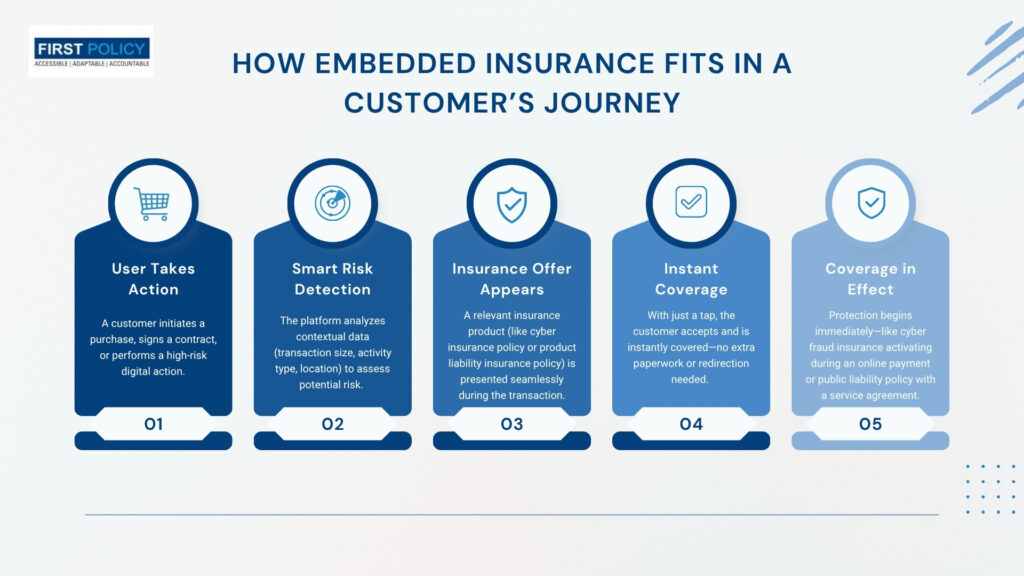
Embedded Insurance: The Next Big Thing in Liability and Credit Coverage
Insurance-related landscape is in the midst of fundamental change. What used to be a lonely stand alone deliberate decision is now being smoothly integrated in both consumer and operation level operations. This reality – called embedded insurance – goes beyond being a technological advance; it is a redefinition of how people think about and engage with insurance. In light of the desire to provide frictionless customer experience among businesses and digital platforms, embedded insurance becomes a force to reckon with especially in terms of liability and credit coverage.
The concept is rapidly spreading in India and across the world. When the size of the embedded insurance market in 2025 is estimated to exceed USD 210.9 billion, and when the forecast of its growth is set to grow at a rate higher than 35% before 2030, it can hardly be said that it is a passing trend. The future of embedded insurance lies in its contextual coverage at the right time and the right place – if you’re booking a ride, buying electronics or borrowing money for your business.
Liability and Credit Coverage: Embedded, Evolved
The conventional liability cover such as public liability policy, product and liability insurance and d&o insurance cover usually requires a separate purchase process, sometimes, a rather tedious process. This friction is taken away with embedded insurance. For example, assume that a business is buying stock from a B2B e-commerce platform. Together with the invoice it is automatically insured with a product liability insurance policy customized to the type of goods and industry risk.
Likewise, businesses that seek to have loans can now have access to credit and liability policy integrated into the lending network. Not only does this raise uptake, but it also provides an extra financial buffer to a borrower. Micro, small and medium enterprises (MSMEs) in India, especially the ones located in Tier II and III cities, gain a lot from such integration. These enterprises get to be shielded from the operational risks without having to search in the market for stand-alone policies as the platforms come along with the built-in commercial general insurance.
Cyber and Crime Insurance: Rising Stars in Embedded Models
As digital transformation tears through, cyber threats and financial crimes shoot up. As there is unimaginable increase in ransomware attacks, phishing and data breaches, the demands to purchase cyber insurance policy and cyber fraud insurance are skyrocketing. Embedded models have now enabled fintech platforms and neo-banks to provide these protections from their apps. For instance, an Indian based digital wallet user while performing a high value transaction can be provided with cyber insurance India coverage at the point of checkout.
Risks associated with crime are also being covered by embedded crime insurance alternatives. Companies that are in industries that have high cash flow such as logistics, or retail can get instant insurance quotations from transaction data. Such a data-centric approach would only be available due to the strong Embedded insurance technology stack that has AI, APIs and blockchain elements.
Embedded Insurance in Practice: Platform-Centric Innovation
Some of the main industries are already developing or embracing the embedded insurance systems. Ecommerce players are adding return shipping insurance. Ride-sharing apps offer the driver liability protection. Buy now pay later platforms are integrating protection plans for payment. Low-code insurance solutions that enable developers to bring insurance features quickly, without extensive coding, is what makes these models beautiful.
From the backend point of view, with embedded insurance API integration, the traditional insurers are able to partner with digital first firms. Insurers do not have to create every product’s direct-to-consumer pipeline; instead, they plug into ecosystems where the insurance will be an organic part of the transaction. This is what is termed as insurance-as-a-service by experts (IaaS).
What’s Missing: Claims and Consumer Awareness
In most discussions, people tend to concentrate more on distribution and growth, and they forget to pay attention to the user’s post-purchase experience, especially the claims management. In the embedded insurance, the claims process should be as smooth as the policy issuance. Unfortunately, many platforms do not offer real-time claims support or even understandable information on the process of claiming.
Another gap is consumer education. Many of the affected customers do not know the coverage that they have taken or if they even have one. For example, a company may be insured, without even knowing, under a public liability policy that comes along with their subscription to a supply chain platform. Informing users with smart notifications, FAQ and embedded content are fundamental to driving maximum value.
Risk-Specific Coverage: Tailored, Not Generic
The possibility to customize the coverage is one of the most powerful, but not widely used benefits of Embedded insurance. The enterprises that are highly vulnerable to cyber threats, such as digital service providers can get hyper-targeted cyber insurance policy options, whereas, logistics startups can be auto-attached to the crime insurance plan involving employee theft.
Even within liability insurance, embedded solutions can distinguish between industries. A pharmaceutical supplier may be made stricter product liability insurance policy clauses as compared to a fashion retailer. That is what makes embedded insurance different from the traditional insurance models: its flexibility to use coverage customization based on the user’s data on the fly.
The Role of Insurtech and Regulation
The insurtech companies are playing a central role in venturing into embedded insurance models. Using innovative tools and partner ecosystems, they are driving digital transformation in insurance. But regulators are now coming up to speed. The IRDAI in India is looking at structures that guarantee that embedded insurance is clear, genuine, and does not confuse consumers.
This entails opportunities in embedded insurance to serve more people, more effectively and efficiently, but also challenges to its adoption such as compliance, data security and cross border issues for global bodies.
Use Case Deep Dive: Liability and Cyber Risk for SMEs
Small and medium businesses are usually under huge liability risk with limited insurance covers. Conventional insurance is either too expensive or complicated. It is bridged by embedded models. Fintech platforms providing SME loans can now incorporate the coverage of liability policy to reduce the dangers of a borrower defaulting owing to unexpected liabilities.
On the same note, startups that are taking advantage of cloud services and digital payment are more likely to suffer from cyber threats. Ingraining a cyber fraud insurance into the tools that they are already using, such as an accounting tool or a CRM software provides the real time and relevant protection. The good thing is that; such insurance can emerge to be dynamic with the use of smart contracts and the usage-based models.
Embedding Coverage in the Customer Journey

Through point-of-sale integration only, those providers who want to fully unleash their embedded insurance potential will fail to do so if they do not integrate throughout the customer journey. Imagine onboarding triggers, upgrade of products, or behaviors of users who require insurance at any point. For instance, an increase in the volume of transactions carried out through the internet may trigger a proposal for improved cyber insurance India coverage.
Even better, an AI-fuelled nudge can recommend improved d&o insurance coverage upon the expansion of the board of a private limited company or when funding is raised. On the same note, an increase in customer complaints may mean an upgrade in the product and liability insurance. These are not the theoretical features – they’re already tested by the leading platforms throughout India and Southeast Asia.
Final Thoughts: A Paradigm Shift in Protection
There is no longer a convenience to embedded insurance – it is now a strategic necessity. From providing bundled commercial general insurance to providing real-time cyber insurance policy options, the industry is shifting to the active, data-driven protection models as fast as possible. To the businesses looking for agility and to the insurers aiming for modernization of distribution–this convergence of technology, data, and customer-centric design is the most exciting change in decades.
With the flow of time, stakeholders that will blossom in the embedded insurance industry trends will be the ones who focus on flexibility, education and integration.
FAQ’s
It bundles liability or credit protection directly into business activities like loans or B2B purchases, removing the need for separate policy shopping.
Fintech apps have, nowadays, begun to provide cyber and fraud insurance during transactions; whereas retail platforms leverage real time data to give an instant crime cover quotation.
Poor claims support and lack of user awareness are key issues. Many users don’t know they’re covered or how to file claims.
It aims to automate and integrate claims directly into the user journey, but many platforms still lack real-time, user-friendly processes.





